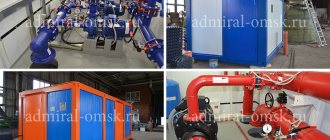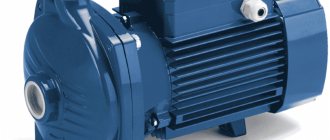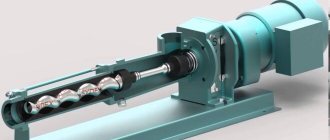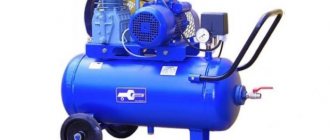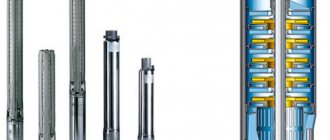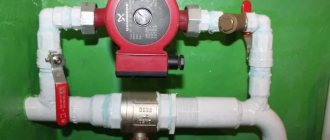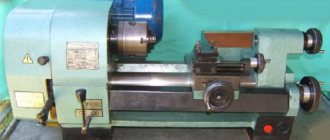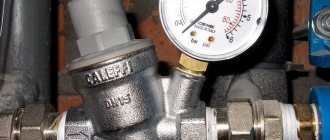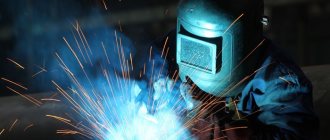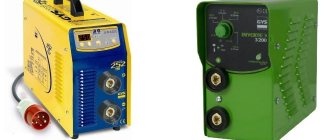Pumps are used to supply water to a home or water a garden. They come in different types and designs, and each of them has its own area of application. If you need an inexpensive and reliable device for pumping water from a well, deck or some kind of container, pay attention to a self-priming pump. These are relatively inexpensive devices that are installed on the surface and can pump water from a fairly decent depth - 8-9 m. If necessary, the models are supplemented with ejectors, then the suction depth increases to 20-35 m.
Purpose of self-priming pumping units
Their operation is possible in the following directions:
- for domestic needs - pumping water for drinking, irrigation or filling swimming pools;
- at industrial enterprises requiring rapid movement of diesel fuel, fuel oil, chemically aggressive reagents and coarse systems;
- in construction – for maintenance of engineering structures;
- in agricultural production - irrigation and application of liquid fertilizers, supply of water and liquid feed to livestock complexes;
In addition, they are used in the work of public utilities for the distillation of wastewater of varying degrees of contamination and for fire fighting.
Types of construction
Surface centrifugal pump As the name suggests, surface models are located on the ground, and water flows into them from a well through a hose.
The operation of such equipment is simple; the average pump pumps water from a depth of 10–12 m to a height of about 30 m.
Submersible centrifugal pumps are cylindrical in shape. They are installed directly in a well under water. If the water lies below 20 m, then the submersible type of unit should be considered. In turn, this type of pumps is usually divided into standard and deep.
Specialist note: up to a depth of 50 meters, a standard submersible pump will be sufficient. But if the water intake level is much lower, then this is work for a deep submersible pump.
Single Stage Centrifugal Pump
Single-stage pumps are those with one, usually large, impeller. This scheme is currently used only in surface pumps.
In multistage centrifugal pumps for water and other liquids, there can be up to seven wheels on one axis: the greater the number of simultaneously rotating wheels, the better the engine performance.
Medium-pressure centrifugal pumps are in the range of 0.2–0.6 MPa; low- and high-pressure pumps are located in the ranges below and above these values, respectively.
Self-priming pump device
Its internal mechanism is based on two main elements:
- an electric motor, the shafts of which communicate through a coupling with the shafts of the pump itself;
- working chamber. It contains a discharge element, which consists of moving wheels with blades. It is responsible for the formation of a low pressure zone and initiates the rise of water.
The quality of the pump is determined primarily by the sealed joint of the shafts, which directly depends on the type of sealing material of the couplings.
conclusions
Does your dacha already have a self-priming pump?
Of course! No, but it will be!
To summarize, it is worth noting the following:
- The most suitable for home use are dynamic self-priming pumps of centrifugal and vortex types. They are able to provide both irrigation and water supply in the house.
- Maximum performance with a self-priming pump can be achieved by carefully observing the requirements for the installation location of the device, its process and operation.
- Select options that suit your specific needs and are able to work correctly under the conditions you specify.
- Before starting the self-priming pump, check the quality and tightness of the connections, the quality of the incoming liquid, the correct placement of the pipelines to the installation and the level of immersion of the hose in water.
Classification of self-priming devices
Depending on the mode of operation, all pumps can be divided into the following groups:
- self-priming centrifugal pumps - can be used for both drinking and contaminated water containing suspended particles in the form of rust and sand. There are single- and multi-stage,
- vortex impeller - they do not require immersion in water before operation. At the same time, their throughput and pressure are of great importance;
- ejector - operate on the principle of vortex equipment. However, thanks to a separate pipe, it is possible to increase the suction depth and extract water even from deep-sea wells.
A separate category of vortex pumps are pumping devices with reverse, suitable for hot water, liquid dairy products, sunflower oil, wine, fuel and their distillation in different directions.
Depending on the method of use, pumps are:
- surface – installed at a distance from a specific water intake;
- submersible - lowered to the bottom of wells or tanks with liquid.
A separate type of centrifugal pumping equipment are:
- self-priming mud pumps, effective for dirty water with inclusions no larger than 1 cm in size.
- oil pumps - suitable not only for petroleum products, but also sewage, liquefied gas, waste water, paraffin and many other viscous and heterogeneous media.
Next, we propose to consider some of the most popular models of domestically produced self-priming pumps and familiarize yourself with their characteristics.
Ejector
The greatest depth from which surface vortex and centrifugal pumps can lift water is 8-9 meters; it is often located deeper. To “get” it from there, an ejector is installed on the pumps. This is a specially shaped tube that, when water moves through it, creates a vacuum at the inlet. So such devices also belong to the category of self-priming. An ejector self-priming pump can lift water from a depth of 20-35 m, and this is more than enough for most sources.
Connection diagram for a remote ejector for wells of different diameters - two-inch on the right, four-inch on the left
The disadvantage is that in order to ensure operation, part of the water must be returned, therefore, productivity is significantly reduced - such a pump may not provide a very large water consumption, but no less electricity is spent to ensure operation. When installing an injector in a well or well of sufficient width, two pipelines are lowered into the source - one supply of a larger diameter, the second, return, of a smaller diameter. An ejector is connected to their outputs, and a filter and check valve are installed at the end. In this case, the disadvantage is also obvious - double pipe consumption, which means a more expensive installation.
In small-diameter wells, one pipeline is used - the supply one, and instead of the return line, the well casing pipe is used. In this way, a rarefaction zone is also formed.
Submersible pump TsMK 25 20 S
Designed for the distillation of waste industrial, rain and domestic wastewater, as well as fecal waste from livestock farms by centrifugal force.
Peculiarities:
- monoblock design;
- vertical installation;
- working chamber in steel and cast iron;
- a mechanical seal protected by the crankcase from premature drying out;
- not suitable for use in fire and explosion hazardous areas.
Specifications:
- The range of permissible water acidity is 6-8 pH;
- The maximum permissible wastewater temperature is 45 0C;
- Pumping speed – 0.42 m3/min;
- Head – 20 m;
- Power indicator – 3500 W.
Rules for choosing wisely
Before purchasing, you should read the information contained in the product data sheet. You need to be interested in the following information:
- Power and productivity - this indicator must be compared with the distance of the well from the house, the number of water distribution points and the maximum volume of water required at any given moment. Naturally, this will require precise mathematical calculations. However, by correctly calculating the required pump power, you can extend its service life, as well as avoid premature breakdowns and overheating;
- The minimum output pressure should be 0.3 Bar. Otherwise, household appliances connected to plumbing communications may fail.
- It is also necessary to correlate the capabilities of the pump with the diameter of the casing pipe installed in the well. It is better to contact the specialists who carried out the drilling with this question.
Pump for dairy farms GNV2 25 30 s
The stainless steel design of the body and internal impeller allows this device to be effectively used for transporting milk and liquid food solutions.
Peculiarities:
- primitiveness of the design, which determines its durability and ease of maintenance;
- easy to clean – the body can be assembled and reassembled after washing, even for an inexperienced user;
- small size;
- horizontal localization of the device.
Technical specifications:
- Maximum t оС – 90;
- Motor – 5500 W;
- Impeller torque – 3 thousand rpm;
- Productivity – 0.42 m3/min;
- Head (m) – 30;
- Weight – 55 kg.
Design features and principle of operation
The design and operating principle of a centrifugal pump have not fundamentally changed since the 17th century. The pump consists of the following parts and assemblies:
- The energy source is an electric (or gasoline) engine mounted on the same shaft with the pumping part of the mechanism itself.
- Shaft supported by bearings.
- An impeller with blades on its surface.
- Housing with flow-directing profiles.
- Shaft seals.
- Inlet pipe located on the axis of the product.
- The outlet pipe is located at the outer wall of the housing, tangential to it.
Centrifugal pump device
In addition to the listed main components, the centrifugal pump is equipped with auxiliary ones:
- Inlet and outlet hoses or pipelines.
- A shut-off valve that prevents fluid from flowing in the opposite direction.
- Filter.
- Manometer for measuring the pressure of a liquid medium.
- Dry running sensor that turns off the pump if there is no liquid in the line.
- Taps and valves for pressure control.
The operating principle of a centrifugal pump is simple:
- When the impeller rotates, its blades capture the liquid medium and carry it along with them
- Centrifugal forces arising during rotation of the liquid push it towards the outer walls of the housing, where excess pressure is created
- The pressure pushes the liquid medium into the outlet pipe
- Under the influence of the vacuum created in the center of the pump, the next portion of liquid is sucked from the receiving pipe.
Operating principle of a centrifugal pump
Changes and additions can be made to the design of a centrifugal pump aimed at increasing its efficiency and adapting it to the specific fluid being pumped.
Pump CG 25 50 s
Single-stage monoblock pump. has a sealed and chemically resistant design, which determines the possibility of use in the chemical, oil refining, food industries and pharmaceutical plants.
Peculiarities:
- absence of seals in the structure;
- the materials used for the body and working parts are chemical, fire and explosion resistant;
- wide range of use.
Specifications:
- Operating temperature range – 50-100 °C;
- Motor – 7500 W;
- Torque – 3 thousand rpm;
- Feed rate – 25 m3/h;
- Liquid pressure – 50 m.
Ejector - a device for deep sources
For pumping water from wells more than 8 m deep, only powerful submersible units are suitable. Their disadvantages are high price, difficulty in maintenance and repair, and high energy consumption. It is cheaper and easier to install a surface pump with an ejector (ejector, ejector).
An ejector is a device that transfers kinetic energy to a fluid jet moving at high speed to the pumped medium. There are two types of these devices:
- Submersible (remote, external). It is installed at the bottom of a well or well on the suction line above the check valve. Suction depth – up to 30 m.
- Built-in (internal). The device is located inside the pump. The suction depth increases slightly - up to 9 m.
For use in the garden, you can make an ejector with your own hands.
LPG pump 63 20 s
It is a type of cryogenic equipment designed to move gases in a liquefied phase (nitrogen, propane) through pipelines. Suitable for use as part of stationary or mobile gas installations to maintain continuous gas supply to main channels or directly to the consumer.
Peculiarities:
- ease of control and durability;
- high productivity and the ability to adjust it;
- operation from a 3-phase network;
- operation in a wide range of environmental conditions.
Specifications:
- Productivity – 4.17 l/min;
- Pressure – 22.5 MPa;
- Engine – 4400 W;
- Weight – 200 kg.
BCPN 63 30 s
A type of downhole equipment operating on the centrifugal principle. It will be a good helper for household needs that require the supply of fresh and slightly salted water from above-ground and underground sources.
Advantages:
- high-quality motor part with a 2-phase winding, making it possible to start it at voltages below 220 V;
- stainless steel body;
- integrated starting device;
- The starter is equipped with a thermal relay, which provides additional protection in case of power surges.
Technical features:
- Operating speed – 2.3 m3/h;
- Permissible working depth – 15 m;
- Engine – 660 W;
- Pressure – 30-38 m;
- Weight – 13.5 kg.
Correct installation of the suction line
The suction line is the pipeline through which the liquid moves towards the surface pump. This pipeline is connected to the inlet pipe. The shorter the length of this line, the better. Before entering the unit, there must be a straight section of at least 2 pipe diameters in length. Most of the line is most often located vertically and ends at the bottom of a well, well, pit, or tank. The pipeline is made without sharp transitions with a minimum number of joints and bends. Connections must be tight. A slope of at least 5 mm per 1000 mm is required.
A bottom check valve is installed at the liquid inlet into the pipe: without it, when pumping is stopped, the working medium flows back down under the influence of gravity, air pockets form in the pipeline, and the pump operates in dry running mode, which leads to its rapid breakdown. In the operating instructions for the device, the manufacturer indicates the minimum distance from the bottom to the entrance to the suction line and the minimum length of the line from the check valve to the level of the liquid surface.
Submersible self-priming pump ECV 63 50 s
It is used for pumping water of various levels of mineralization, the temperature of which does not exceed 25 0C.
Peculiarities:
- power supply from 3-phase network;
- stainless steel body;
- resistance to intense loads.
Technical specifications:
- Throughput capacity – 63 m3/h;
- Permissible working depth – 15 m;
- Engine – 660 W;
- Head – 50 m;
- Mineralization of solutions – up to 1.5 g/l;
- Weight – 112 kg.
Instead of an epilogue
When choosing a suction pump, you must always remember that it is complex technical equipment, so before purchasing you should clearly establish the purposes for which it is being purchased. Using a pump that is not suitable for a certain type of work will invariably lead to its failure. You should also pay attention to the warranty period: does it correspond to the type of equipment purchased? As a rule, it is larger for centrifugal ones, and smaller for vortex ones. It is better to buy a pump through online trading platforms, thus saving yourself from unnecessary retail markups.
